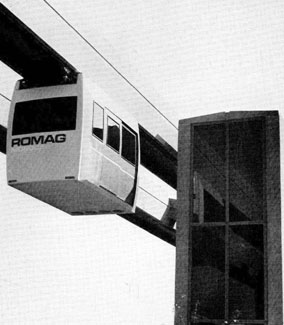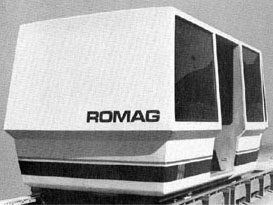The ROMAG Maglev GRT Technology
 In the late 1960s, the Rohr Corporation of Chula Vista, California developed a
PRT technology that utilized linear induction motors for propulsion and suspension. The
controllers for these motors were of the voltage variable-frequency type. The motor
windings were attached to the vehicle. The passive ferro-magnetic rail acted as the
stator. The rail could be beneath the vehicle or overhead. Two motors - one along each
side of the vehicle - would be normally used. The motors were designed to be quiet,
non-polluting, free of wearing parts, insensitive to wet or icy guideways, capable of
high-speed operation and able to operate efficiently over significant grades. The magnetic
suspension system was noiseless, had no moving parts and was capable of being programmed
to provide a smooth, comfortable ride.
In the late 1960s, the Rohr Corporation of Chula Vista, California developed a
PRT technology that utilized linear induction motors for propulsion and suspension. The
controllers for these motors were of the voltage variable-frequency type. The motor
windings were attached to the vehicle. The passive ferro-magnetic rail acted as the
stator. The rail could be beneath the vehicle or overhead. Two motors - one along each
side of the vehicle - would be normally used. The motors were designed to be quiet,
non-polluting, free of wearing parts, insensitive to wet or icy guideways, capable of
high-speed operation and able to operate efficiently over significant grades. The magnetic
suspension system was noiseless, had no moving parts and was capable of being programmed
to provide a smooth, comfortable ride.
A ROMAG test vehicle was successfully tested on March 6, 1971. It was the first time in the U.S. that a person rode a vehicle supported and moved by magnetic forces.
 Sometime during the late 1970's, this technology was purchased by the Boeing
Company of Seattle. At that time, Boeing had a group working on the Advanced Group Rapid
Transit project with federal funding. The federal funding was stopped and Boeing stopped
work on this topic. No further work on ROMAG was done by Boeing and it is said that the
ROMAG materials are currently located in the basement of a professor at Carnegie-Mellon
University in Pittsburgh. No confirmation of this information is available.
Sometime during the late 1970's, this technology was purchased by the Boeing
Company of Seattle. At that time, Boeing had a group working on the Advanced Group Rapid
Transit project with federal funding. The federal funding was stopped and Boeing stopped
work on this topic. No further work on ROMAG was done by Boeing and it is said that the
ROMAG materials are currently located in the basement of a professor at Carnegie-Mellon
University in Pittsburgh. No confirmation of this information is available.
Three additional ROMAG photos are also provided on a separate page. Thanks to James Dumke for making them available.
Last modified: May 09, 2006